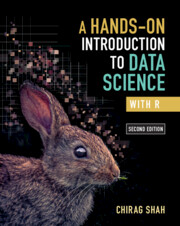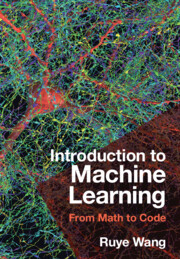Refine search
Actions for selected content:
1011 results

A Hands-On Introduction to Data Science with Python
- Coming soon
-
- Expected online publication date:
- January 2026
- Print publication:
- 22 January 2026
-
- Textbook
- Export citation

A Hands-On Introduction to Data Science with R
- Coming soon
-
- Expected online publication date:
- January 2026
- Print publication:
- 22 January 2026
-
- Textbook
- Export citation

Introduction to Machine Learning
- From Math to Code
- Coming soon
-
- Expected online publication date:
- January 2026
- Print publication:
- 18 December 2025
-
- Textbook
- Export citation
Strategizing AI utilization for psychological literature screening: A comparative analysis of machine learning algorithms and key factors to consider
-
- Journal:
- Research Synthesis Methods ,
- Published online by Cambridge University Press:
- 19 December 2025, pp. 1-32
-
- Article
-
- You have access
- Open access
- HTML
- Export citation
4 - Varieties of Expertise
-
- Book:
- Negotiating Values
- Published online:
- 30 November 2025
- Print publication:
- 18 December 2025, pp 76-99
-
- Chapter
- Export citation
Chapter 9 - Statistical Modelling of Syntactic Complexity of English Academic Texts Using Ensemble Machine Learning
-
-
- Book:
- Data-Intensive Investigations of English
- Published online:
- 03 December 2025
- Print publication:
- 18 December 2025, pp 227-257
-
- Chapter
- Export citation
Revisiting the Paradoxes of Knowledge Diversity and Network Structure for Team Innovation: A Machine-Learning Inductive Study
-
- Journal:
- Management and Organization Review / Volume 21 / Issue 4 / August 2025
- Published online by Cambridge University Press:
- 18 December 2025, pp. 794-822
-
- Article
- Export citation
Uncertainty quantification for deep learning
-
- Journal:
- Environmental Data Science / Volume 4 / 2025
- Published online by Cambridge University Press:
- 17 December 2025, e53
-
- Article
-
- You have access
- Open access
- HTML
- Export citation
Stay Tuned: Improving Sentiment Analysis and Stance Detection Using Large Language Models
-
- Journal:
- Political Analysis , First View
- Published online by Cambridge University Press:
- 17 December 2025, pp. 1-20
-
- Article
-
- You have access
- Open access
- HTML
- Export citation
Political DEBATE: Efficient Zero-Shot and Few-Shot Classifiers for Political Text
-
- Journal:
- Political Analysis , First View
- Published online by Cambridge University Press:
- 15 December 2025, pp. 1-15
-
- Article
-
- You have access
- Open access
- HTML
- Export citation

Statistics for Chemical Engineers
- From Data to Models to Decisions
-
- Published online:
- 12 December 2025
- Print publication:
- 25 September 2025
-
- Textbook
- Export citation
Towards equitable governance of human genomic data sharing: guided by genomic contextualism
-
- Journal:
- Data & Policy / Volume 7 / 2025
- Published online by Cambridge University Press:
- 11 December 2025, e83
-
- Article
-
- You have access
- Open access
- HTML
- Export citation
When does machine learning outperform clinicians? A comparison of prediction accuracy for PTSD treatment outcomes
-
- Journal:
- Psychological Medicine / Volume 55 / 2025
- Published online by Cambridge University Press:
- 11 December 2025, e376
-
- Article
-
- You have access
- Open access
- HTML
- Export citation
Symbolic identification of tensor equations in multidimensional physical fields
-
- Journal:
- Journal of Fluid Mechanics / Volume 1024 / 10 December 2025
- Published online by Cambridge University Press:
- 02 December 2025, A34
-
- Article
- Export citation
Physics of the vortex gust–airfoil interaction under an optimal mitigation strategy learned through deep reinforcement learning
-
- Journal:
- Journal of Fluid Mechanics / Volume 1024 / 10 December 2025
- Published online by Cambridge University Press:
- 01 December 2025, A18
-
- Article
- Export citation
Global trends and future projections of eating disorders among adolescents and young adults: comprehensive analysis from 1990 to 2050 using eight machine-learning models
-
- Journal:
- The British Journal of Psychiatry , FirstView
- Published online by Cambridge University Press:
- 27 November 2025, pp. 1-15
-
- Article
-
- You have access
- Open access
- HTML
- Export citation
Neural operator-based stochastic forcing for resolvent prediction of space–time turbulence statistics in channel flows
-
- Journal:
- Journal of Fluid Mechanics / Volume 1024 / 10 December 2025
- Published online by Cambridge University Press:
- 25 November 2025, A1
-
- Article
- Export citation
Only-child matching penalty in the marriage market
-
- Journal:
- Journal of Demographic Economics , First View
- Published online by Cambridge University Press:
- 24 November 2025, pp. 1-35
-
- Article
-
- You have access
- Open access
- HTML
- Export citation
10 - The Future of Chilling Effects and How to Stop It
- from Part III - Implications
-
- Book:
- Chilling Effects
- Published online:
- 20 November 2025
- Print publication:
- 20 November 2025, pp 168-189
-
- Chapter
- Export citation
Jurisprudence and the Intelligible World: Exploring Predictive Modelling as a Mechanism to Decide Bail in the Australian Context
-
- Journal:
- International Annals of Criminology , First View
- Published online by Cambridge University Press:
- 20 November 2025, pp. 1-37
-
- Article
-
- You have access
- Open access
- HTML
- Export citation


